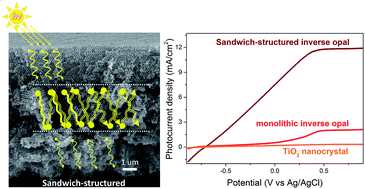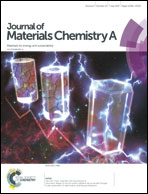Sandwich-structured TiO2 inverse opal circulates slow photons for tremendous improvement in solar energy conversion efficiency†
Abstract
Photon management has enabled a true revolution in the development of high-performance semiconductor materials and devices. Harnessing the highest amount of energy from photons relies on the ability to design and fashion structures to trap the light for a longer time inside the device for more electron excitation. The light harvesting efficiency in many thin-film optoelectronic devices is limited due to low photon absorbance. Here we demonstrate for the first time that slow photon circulation in sandwich-structured photonic crystals with two stopbands fine tuned is ideally suited to enhance and spectrally engineer light absorption. The sandwich-structured TiO2 inverse opal possesses two stopbands, whose blue or red edge is respectively tuned to overlap with the electronic excitation energy of TiO2, thereby circulating the slow photons in the middle layer and enhancing light scattering at layer interfaces. This concept, together with the significantly increased control over photon management opens up tremendous opportunities for the realization of a wide range of high-performance, optoelectronic devices, and photochemical reactions.



 Please wait while we load your content...
Please wait while we load your content...